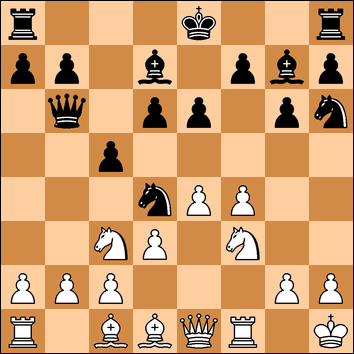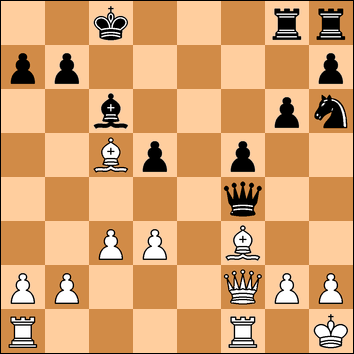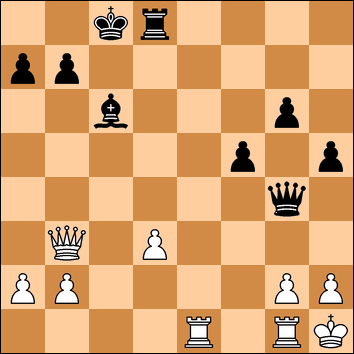Swale Club Chess Championship - Round Eleven
Thursday 31 January 2019
White: Keith Nevols (163) Black: Andrew Gillard (105)
Sicilian Defence
1. e4 c5
2. Nc3 Nc6
3. f4 d6
4. Nf3 e6
5. Be2 Bd7
6. O-O g6
Black adopts a different set-up to our last game but once again delays castling.
7. Qe1 Bg7
8. d3 Qb6
9. Kh1 Nd4
10. Bd1
A similar set-up to the positions I have had before, and remembering to tuck the king away.
10. .... Nh6
The engine prefers 10. .. Ne7 but declares this position to be equal.

11. Ne2 O-O-O
So Black prepares to attack on the kingside.
12. Nd2 d5
13. c3 Nxe2
14. Bxe2 Rdg8
Now I know where the black king is, I can prepare to set up an attack and point my pieces towards the left of the board.
15. Bf3 Bc6
16. Nb3
Zoning in on the c5 pawn.
16. ........ Bf8
Zoning in on the c5 pawn.
16. ........ Bf8
17. Be3
The engine recommends 17. exd5 but I did not want to free the f5 square for the Black knight, and after the text, 17. ... dxe4 18. dxe4 would have kept the knight on the rim looking dim.
17. ..... f5
The Black knight now cannot get to f5, so it is safe to exchange with the added bonus of winning a pawn.
18. exd5 exd5
19. Qf2 Qc7
20. Nxc5 Bxc5
21. Bxc5 Qxf4!?

Black instead decides to sacrifice the exchange, and, in return, gets a strong attack.
22. Bd4 Ng4
23. Bxg4?
The first mistake. 23. Qg1 is best to consolidate. The key to the Black counterattack is that bishop on c6. At the moment, it is blocked by the pawn on d5, and is opposed by the bishop on f3. My next two moves remove my own obstacles.
23. ..... Qxg4
The fearless engine would now grab a pawn with 24. h3 Qg5 25. Bxh8 Rxh8 26. Qxa7!?
24. Bxh8 Rxh8
There is nothing wrong with 25. Qxa7 but I wanted to consolidate the position, perhaps try to swap queens off. If 25. d4 I was concerned with 25. .. Bb5 26. Rfe1 Bd3 and whether I could win around a bishop planted on e4. I also wanted to get the other rook into the game.
25. Rae1? d4!
But this is a very good temporary pawn sacrifice, which opens up the bishop on c6, presents White with a backward isolated pawn, and opens up some squares for the queen.
26. cxd4 Rd8
Here 27. d5 is recommended. 27. .. Bxc5 28. Rc1+ Kb8 29. b3 or 27. .. Rxd5 28. Re7.
27. Qe2 Qxd4
28. Qe6+ Rd7
29. Qg8+ Rd8
30. Qb3?
Chickening out of 30. Qxh7 Qg4 31. Rf2 Rxd3, in the hope that 30. .. Qxd3 31. Qxd3 Rxd3 32. Rd1 with a difficult ending still to win.
30. .... Qg4
No such luck!
31. Rg1?! h5!
31. Rf2 would have been more accurate as now I have boxed the king in on a diagonal facing the strong bishop on c6. I cannot move the g-pawn, the h-pawn, the king nor the rook on g1. The final curtain threatened.

32. Qe6+ Kb8
33. Qe5+ Ka8
The queen is better positioned and now it is time for 34. Re3! h4 35. h3, or 34. Qf6.
34. Qc3?
Now the h-pawn gets through.
34. .... h4
35. Qc2 h3
36. Re2
With White now completely tied down, Black could play 36. .. Qd4. Instead he decides to recoup the material.
36. ... hxg2+
37. R1xg2 Bxg2+
37. .. Qh3 or 37. .. Qd4 would have ended up with the d3 pawn falling and Black a pawn up in the ending.
38. Rxg2 Qf3
39. Kg1 Re8
If 39. .. Qxd3 40. Qxd3 Rxd3 41. Rxg6 a6 42. Rg2 and an interesting but even rook ending.
Black threatens Re1 mate.
40. Qd2 Qc6
With the offer of a draw. It is hard to see how White could defend the d-pawn and his king is much less safe than Black's so, with relief, I accepted the draw.
This was my sixth draw in the championship and I was aware that, along with my one loss, I was dropping too many points to be in contention.